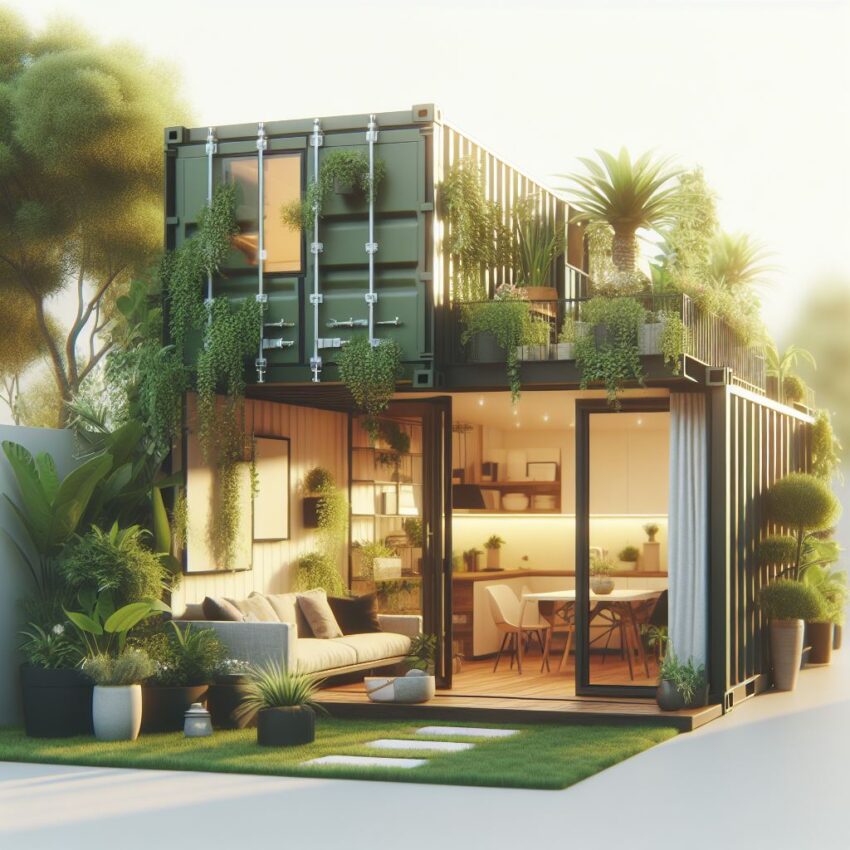
The concept of sustainability has leaped from being a mere buzzword to an essential criterion in home building. Among the innovative approaches that epitomize this green wave is the use of shipping containers as the structural foundation for homes.
The Genesis of Container Homes
The genesis of container homes is an innovative response to the pressing needs for sustainability, affordability, and efficient use of resources in the housing sector. Originating from the creative repurposing of shipping containers, these structures have transcended their initial function of transporting goods across oceans to become a cornerstone of eco-conscious living. Architects and builders harness the inherent strengths of these steel containers – durability, modularity, and availability – to craft homes that stand at the intersection of functionality and design.
The transformation of shipping containers into livable spaces is a profound reinterpretation of architectural norms, challenging traditional construction methods and promoting a minimalist lifestyle. These homes are tailored to reduce environmental footprint through the reuse of excess containers that would otherwise contribute to metal waste, showcasing a brilliant amalgamation of sustainable living with modern aesthetics.
This rise in container home popularity signals a broader paradigm shift towards mindful resource utilization in construction. By integrating advanced insulation techniques, renewable energy sources, and water-saving systems, container homes are evolving to be eco-friendly and highly energy-efficient, meeting the demands of the modern eco-aware homeowner. The modularity of containers allows for diverse and customizable housing solutions, catering to a wide range of preferences and needs.
Benefits of Container Homes
Affordability offers significant cost savings. Unlike traditional housing, they demand a smaller financial investment due to the pre-existing primary structure. This aspect drastically cuts down on labor and material expenses. Consequently, individuals seeking economical housing solutions find container homes appealing. Their affordability extends beyond initial construction, as they often require lower maintenance costs over time. This financial advantage makes them a pragmatic choice for those prioritizing frugality without compromising on quality or functionality in their living arrangements.
Durability is a defining feature of shipping container homes, owing to their origin in ocean transport. Constructed to withstand the rigors of sea travel, these containers exhibit remarkable strength. Their ability to be stacked highlights their structural integrity, ensuring resilience against various environmental challenges. This inherent robustness translates into durable homes capable of withstanding extreme weather conditions. From storms to temperature fluctuations, container homes offer a secure and long-lasting shelter for occupants.
Sustainability is exemplified in the repurposing of shipping containers for home construction, showcasing upcycling at its finest. Rather than disposing of or melting down these steel structures, transforming them into living spaces offers a new purpose while significantly lowering the carbon footprint linked to conventional home building. This eco-friendly approach aligns with contemporary environmental goals, promoting resource efficiency and reducing waste. By giving shipping containers a second life as homes, individuals contribute to a more sustainable future by minimizing the environmental impact of housing construction.
Innovations in Shipping Container Architecture
Creativity in container home design knows no bounds. Architects and designers are continually pushing the envelope, turning these rectangular boxes into astonishing residences that challenge preconceived notions of living space. From compact, single-container studios to expansive multi-container family homes, these buildings are as diverse as they are innovative. The integration of sustainable technologies, such as solar panels and rainwater harvesting systems, further elevates these homes into models of eco-friendly living.
Notable projects that exemplify the potential of container architecture include:
- The Caterpillar House in Chile, is a sprawling residence that seamlessly blends eco-conscious design with modern aesthetics. It utilizes several containers in its construction, creating a spacious and light-filled dwelling.
- WFH House in China, is a modular home that showcases how containers can be configured to achieve a harmonious balance between indoor and outdoor living.
These examples only scratch the surface of what’s possible in the realm of container home construction, demonstrating both the adaptability and the architectural value of these structures.
Challenges and Considerations
Despite their advantages, building container homes presents unique challenges and considerations for prospective builders. Specialized expertise is essential for modifying containers, especially in terms of insulation to create a comfortable living space. Moreover, navigating local building codes and securing permits can be complex, as regulations vary widely by location. The initial condition of the container is critical; those previously used for hazardous materials may need thorough cleaning or might not be suitable for residential conversion. Consequently, sourcing containers from reputable suppliers is crucial during the planning stage to ensure safety and compliance.
Another consideration is structural integrity. While shipping containers are designed to withstand stacking and transportation, modifications for housing may weaken their original strength. Reinforcements may be necessary to ensure structural stability, especially if removing large sections for windows or doors.
Designing for adequate ventilation, natural light, and space optimization poses additional challenges. Proper planning is required to address these aspects while maintaining the integrity of the container’s structure.
Transporting containers to the building site requires appropriate equipment and coordination, while site preparation may involve leveling, foundation work, and utility connections.
With careful planning, expertise, and attention to detail, container homes offer an innovative solution for eco-conscious individuals seeking distinctive and efficient living spaces.
Your Container Home
Container home living necessitates thorough planning and consideration. Begin by conducting extensive research to understand the intricacies involved. Identify your specific needs, preferences, and budget constraints before proceeding further. Consulting with experienced architects and builders is essential to gain valuable insights and expert advice. They can assist in navigating the complexities of container modifications, ensuring that the end result aligns with your vision.
A critical aspect of container home living is addressing regulatory requirements and obtaining necessary permits. Building codes vary by location, so it’s imperative to understand and comply with local regulations. Failure to do so could lead to delays, fines, or even the halting of construction. Additionally, consider the initial condition of the shipping containers. Containers previously used for hazardous materials may require thorough cleaning or may not be suitable for residential conversion. Source containers from reputable suppliers to ensure quality and safety.
Prioritize structural integrity when planning modifications. Reinforcements may be necessary to maintain the container’s strength, especially if removing large sections for windows or doors. Adequate insulation is also essential for creating a comfortable living environment, particularly in extreme climates.
Coordinate with transportation companies to ensure smooth delivery of the containers to the building site. Site preparation may involve leveling the ground, laying foundations, and connecting utilities.
The Future of Container Homes
The trend of repurposing shipping containers into living spaces is more than a fleeting architectural fad; it is a testament to the evolving nature of sustainable living solutions. As environmental considerations become increasingly paramount in the construction industry, container homes stand out as a beacon of innovation and eco-consciousness.
Their continued popularity and development will undoubtedly spur further advancements in shipping container architecture, making eco-friendly housing a mainstream choice for future generations. With their unique blend of affordability, durability, and sustainability, container homes offer a compelling vision for the future of residential architecture, embodying the principles of sustainable living spaces in their very essence.
Shipping container architecture challenges traditional notions of residential design and highlights the immense potential for innovation in the quest for more sustainable living options. As we move forward, the continued exploration and refinement of container home design will undoubtedly play a pivotal role in shaping the future of eco-conscious living, offering practical, stylish, and environmentally friendly solutions for modern dwellers around the globe.


